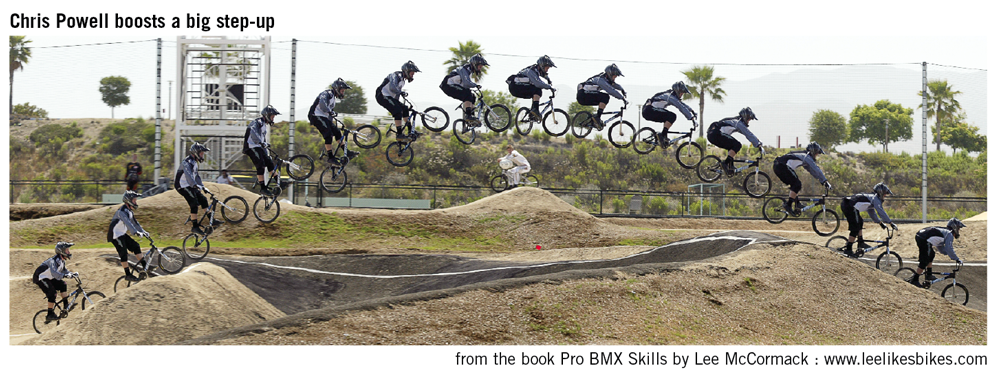Pushing through a BMX double
![]()
Dear Lee,
I bumped onto your site whilst desperately seeking info on a jumping technique that seems to be difficult to find on the web, at least if one doesn’t know the name of it. So in this video that is attached, Mike Day uses it as per text book example in the first jumps after the gate: he pumps the rear wheel mid-air.
http://www.youtube.com/watch?v=JsR_TjG_brU
My question then is, what does this achieve: I think that it is to scrub speed so as to allow for taking the lip of the jump with more speed and then scrub off some mid-air so as to not land too far. Am I correct in my thinking?
Yours,
Rauli
Hey Rauli,
Thanks for the interesting question.
This is a common technique among BMX racers. Some people call it “double pumping.” The modern term is “pushing through.”
Danny Caluag pushes through a double in the book Pro BMX Skills:
 Click for bigger |
Why you do it
Because you are very skilled, and you are going fast, and you want to fly low and fast.
Riders push through jumps they know they will clear. This is an expert technique to carry maximum speed when you have absolute skill and confidence for the situation. There’s a real risk of clipping the frontside of the landing. Use this technique with caution!
How you do it
Jumping gets pretty complex, especially among the best riders, but basically:
• Suck up the jump. This means pushing down hard right before the lip then pulling up over the lip. This absorbs the lifting force of the lip and keeps you lower than if you’d pushing into the lip.
• In the air, push your bike away from you then pull it toward you.
• When you reach the top of the landing, the bike should be very close to you.
Study the above image. I sure learned a lot from watching Danny C ride!
Did I already tell you to be careful with this advanced technique? Learn all about jumping in the book Pro BMX Skills.
Benefits of pushing through
• You stay fluid and dynamic in the air. Anything is better than a dead sailor.
• You can feel out the landing in case you come up short.
• This up-and-down cycle is the same you’d use to pump or manual the same roller-double. If you’re going fast enough to manual, you manual. If you’e going fast enough to jump, you jump. IMPORTANT: You maintain the same up-down rhythmic engagement no matter what. This allows you to use whichever technique you need in the instant, without having to make major changes in your movement or timing. The best riders, like Danny C, mix and match techniques in a blur of power and smoothness. They ALWAYS maintain the same rhythmic engagement. This is a pretty advanced concept. Make sense?
• This is even more esoteric, but I love this stuff so: When you pull your bike toward you, you also pull your body toward your bike. This means your body is even lower when you land, and you get even more pump on the backside. Full racer radness!
• Most of all, pushing through a double is fun. Anything that keeps you loose and happy is going to help you ride better and faster. Do you know who taught me that? Danny C!
In contrast …
Racers rarely push through the biggest jumps. On this monster step-up at the Olympic Training Center in SoCal, Chris Powell pushes into the lip to get maximum boost then keeps his bike close until he’s ready to extend for landing. This approach is more conservative — but pretty sweet.
 Click for bigger |
Have fun out there,
Lee
Know more. Have more fun!
Join the leelikesbikes mailing list:

Leave a Reply
Want to join the discussion?Feel free to contribute!